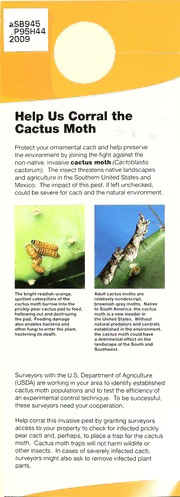
Help us corral the cactus moth PDF
Preview Help us corral the cactus moth
Historic, Archive Document Do not assume content reflects current scientific knowledge, policies, or practices. Help Us Corral the Cactus Moth Protect your ornamental cacti and help preserve the environment by joining the fight against the non-native, invasive cactus moth (Cactoblastis cactorum). The insect threatens native landscapes and agriculture in the Southern United States and Mexico. The impact of this pest, if left unchecked, could be severe for cacti and the natural environment. The bright reddish-orange, Adult cactus moths are spotted caterpillars of the relatively nondescript, cactus moth burrow into the brownish-grey moths. Native prickly-pear cactus pad to feed, to South America, the cactus hollowing out and destroying moth is a new invader in the pad. Feeding damage the United States. Without also enables bacteria and natural predators and controls other fungi to enter the plant, established in the environment, hastening its death. the cactus moth could have a detrimental effect on the landscape of the South and Southwest. Surveyors with the U.S. Department of Agriculture (USDA) are working in your area to identify established cactus moth populations and to test the efficiency of an experimental control technique. To be successful, these surveyors need your cooperation. Help corral this invasive pest by granting surveyors access to your property to check for infected prickly pear cacti and, perhaps, to place a trap for the cactus moth. Cactus moth traps will not harm wildlife or other insects. In cases of severely infected cacti, surveyors might also ask to remove infected plant parts. Prickly pear cacti, the exclusive host of the cactus moth in the United States, grow in 47 States. Cactus pads damaged by the cactus moth will show characteristic oozing of internal plant juices and insect droppings. For information about the cactus moth and its impacts on prickly pear cacti, please visit www.aphis.usda, gov/plant„health/plant_pest_info/cactoblastis/ index.shtmi. Please report your potentially infected cacti to the USDA’s Animal and Plant Health Inspection Service at (850)479-0294. Photo credits: The image of damaged cactus pads was taken by APHIS Plant Protection and Quarantine employee Joel Floyd. The other two photos were taken by Ignacio Baez, a biological science technician with USDA's Agricultural Research Service. USDA is an equal opportunity provider and employer. U.S. Department of Agriculture Animal and Plant Health Inspection Service Program Aid No. 1835 Issued August 2005 Slightly revised August 2009 PORT- A* o G
